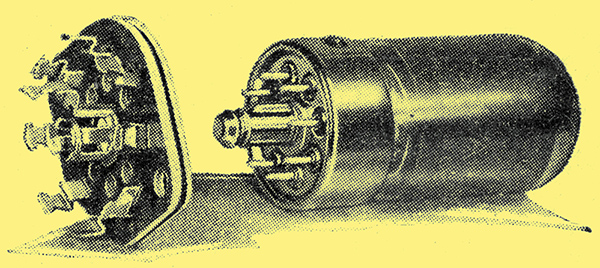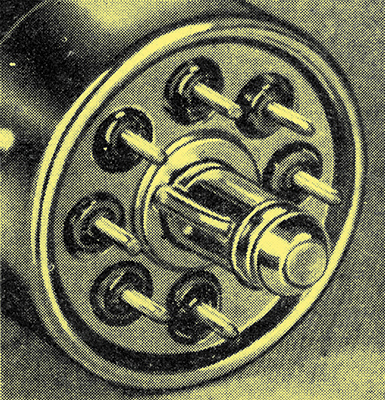|
New Valve on the Loctal Base.

The new Sylvania valve and its holder.
Details of a new American valve of special interest are now to hand this is the type 1231. The special feature of the valve is that although it is a screened pentode it has no top-cap, but all connections are brought out to the 8-pin base. This base is not the conventional moulding, but is a part of the glass envelope of the valve. Actually, the pins are formed of the leading-out wires through the glass. A metal shell fits over the base and bears a metal centre-spigot similar to that of the ordinary octal-base. It also carries a locking device, however, which holds the valve firmly in the socket.
This metal shell and centre-spigot are earthed, and the grid and anode pins are diagonally opposite. Consequently, the spigot acts as a screen between them, thus permitting all leads being taken to the base without destroying the internal screening of the valve.
The particular construction and the absence of a conventional base lead to an extremely small valve with short internal leads and low losses. The length apart from the pins and spigot is only 61 mm and overall 73 mm while the diameter is 30 mm.
It is an indirectly-heated valve taking 0.45 A at 6.3 Volts, and the inter-electrode capacities are: grid to anode, 0.15 pF; grid to earth, 8.5 8.5 pF; anode to earth, 6.5 pF.
When used as a pentode the suppressor is tied to cathode and the valve is operated with 300 Volts for the anode and 150 Volts for the screen. A cathode-bias resistance of 200 Ω should be used, and the anode and screen currents are 10 mA. and 2.5 mA respectively. A mutual conductance of 5.5 mA/V is obtained with an ACresistance of 0.7 MΩ.
By tying the suppressor to screen the valve can be used as a tetrode. The screen and anode potentials and bias resistance are the same, but the anode current rises to 12.0 mA. and the screen current falls to 0.5 mA. The mutual conductance becomes 6.5 mA/V and the AC resistance 0.54 MΩ.
The valve can also be used as a triode. Both screen and suppressor are then joined to anode. The maximum anode potential should be 2 50 Volts and the bias resistance 400 Ω. The anode current is 13 mA, the mutual conductance 6.3 mA/V, and the AC resistance 5,200 Ω.
The valve does not fit a standard octal socket, although the pin arrangement is similar. Adopting the pin numbering of the standard octal base, the connections are: 1, heater; 2, anode; 3, screen-grid; 4, suppressor grid; 5, shield; 6, control grid; 7, cathode; 8, heater. The valve is obtainable in this country from Messrs. Claude Lyons, Ltd., of 40, Buckingham Gate, London, S.W.1, and is priced at 30/-.

Enlarged view of the base of the valve.
The 1231 was superseded by the 7V7.
|